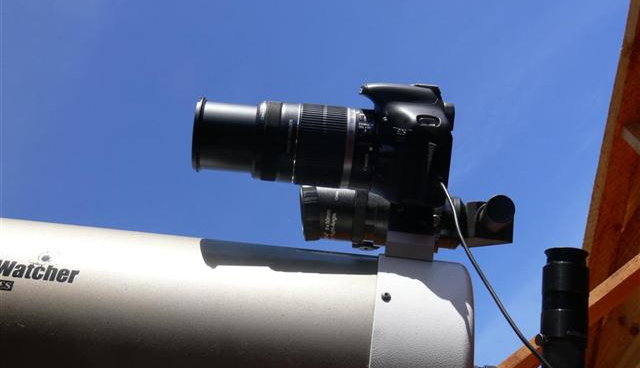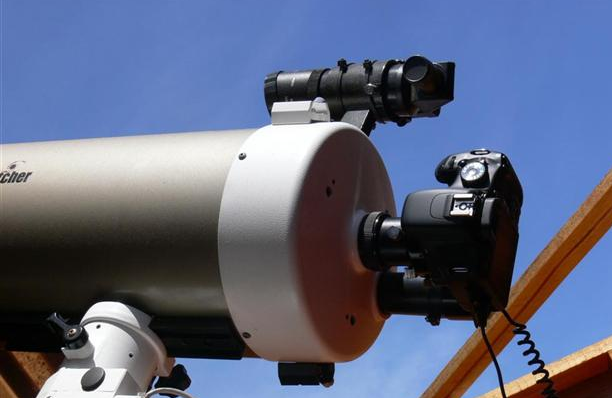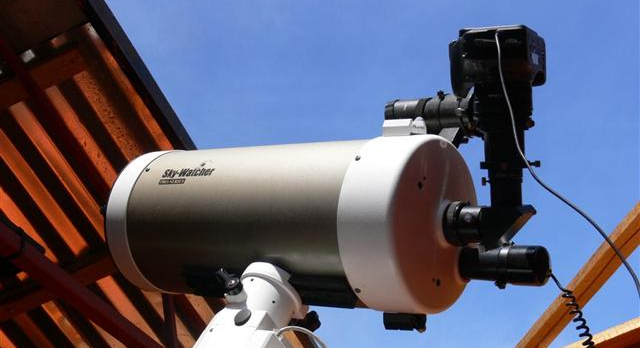On Tuesday 23 October, members of the astro-photography interest group looked at three ways a DSLR camera could be married to a telescope.
AIM: The aim of the meeting was for all members present to be acquainted with three options or fitting the camera to the telescope.
Option 1: Camera rides piggyback on the telescope:
In this option the optical path of the camera is parallel to that of the telescope. The picture shows the camera with its zoom lens extended to 250mm.
This is the equivalent of mounting the camera on a tripod, but with the following advantages:
• The telescope tracks the celestial object and the camera is “kept on target” for the entire photo session.
• Finding the target in the camera is easy, the camera’s field of view is much larger than that of the telescope, and one uses the telescope’s finder scope to find the target.
• Composing the position of the image is easy because fine positional adjustments can be made while the telescope is tracking the target by using the telescope’s slow motion controls.
• The camera’s auto focus function is available.
It is important to know the fields of view for the camera’s different lens settings. In the case of the Canon 505D DSLR different focal lengths give the following fields of view:
|
Focal length (mm) |
Horizontal field of view in degrees |
Vertical field of view in degrees |
Min F-stop that can be set |
|
|
18 – 55mm |
18 |
69.77 |
46.51 |
3.5 |
|
24 |
54.27 |
36.18 |
4.0 |
|
|
35 |
37.57 |
25.05 |
4.5 |
|
|
55 |
24.02 |
16.01 |
5.6 |
|
|
55 – 250mm |
55 |
23.63 |
15.75 |
4.0 |
|
70 |
18.55 |
12.36 |
4.0 |
|
|
100 |
12.85 |
8.57 |
5.0 |
|
|
135 |
9.64 |
6.43 |
5.0 |
|
|
200 |
6.29 |
4.19 |
5.6 |
|
|
250 |
5.37 |
3.58 |
5.6 |
Option 2: The camera has its lens removed and is fitted with an adapter to fit the draw tube of the telescope. The camera is therefore replacing the eyepiece. This is called prime focus photography and in this option the camera uses the telescope as its lens.
This option provides the clearest picture because the number of lenses in front of the sensor is drastically reduced and so reducing propagation losses. This option has both advantages and disadvantages:
• The target is easy to find using the finder scope AND an eyepiece. Once the target is centered in the field of view, the eyepiece is removed and replaced by the camera.
• Tracking is engaged so the camera will remain on target. Fine positional adjustments can be made with the telescope’s slow motion controls.
• Field of view is fixed for the specific camera and telescope combination: In my case the field of view is 28 arc minutes by 18.7 arc minutes.
• In this mode one loses the functions inherent in the camera’s lens: One cannot adjust the aperture size, the sensor sensitivity setting (ISO) and exposure time are used to adjust exposure, the auto focus function is lost and the telescope itself must be focused (I have a remote focusing system to enable me to focus the telescope from the controlling computer).
Option 3: The camera lens is fitted with an adapter to slide over the eyepiece. The image in the eyepiece is actually photographed, both the eyepiece and camera lens are focused on infinity. This is known as afocal photography.
In this mode of photography, the eyepiece and telescope focal length define the magnification and the field of view as well as the magnification. For my telescope (focal length 2,700mm) these values are given in the table below:
|
Eyepiece |
Magnification |
Field of view |
|
40 mm |
67.5 x |
33’ |
|
20 mm |
135 x |
22’ |
|
15 mm |
180 x |
15’ |
An afocal setup is shown below:
In this case the camera lens looks down into the eyepiece. I find it handy to use the diagonal so rotated that the camera looks down and can just be lowered onto the eyepiece (prevents it from falling out!).
The advantages of this option are the following:
• The target is easy to find using the finder scope AND an eyepiece. Once the target is centered in the field of view, the camera is fitted onto the eyepiece.
• Tracking is engaged so the camera will remain on target. Fine positional adjustments can be made with the telescope’s slow motion controls.
• Lens functionality is fully available, one can use auto focus as well as aperture control.
• One can adjust the field of view by changing eyepieces. The 40mm eyepiece will give the largest field of view. I also have a 21mm to 7mm zoom eyepiece available that provides fields of view ranging from 13 arc minutes to 8 arc minutes.
The one major disadvantage is that the light passes through a large number of lens elements before it reaches the sensor and this option has the largest propagation loss.
The adapters used for afocal and prime focus photography are the following:
PHOTOS TAKEN
We took a number of photos that evening. The sensor size is 5184 x 3456 pixels. The photos taken has a a file size up to 3 MB. In order to send them by internet I have resized them to 1024 x 768 pixels. They have all been zipped into one file. I have also included two photos of Saturn as well as a cropped image of each of the Saturn photos.
MOON
We took the following pictures of the moon:
• Camera only with 100mm lens
♦ I have cropped that to 1000 x 800 pixels to show a larger picture on the screen and then resized it to 1024 x 768.
• Camera only with 250mm lens
♦ I have cropped that to 1000 x 800 pixels to show a larger picture on the screen and then resized it to 1024 x 768.
• Camera at prime focus
• Camera mounted afocal with 50mm lens.
SATURN
I have added two photos taken of Saturn
• Afocal on 40mm eyepiece. Photo taken 28 January 2012
♦ I have cropped that to 1000 x 800 pixels to show a larger picture on the screen and then resized it to 1024 x 768.
• Camera in prime focus. Photo taken 19 June 2012
♦ I have cropped that to 1000 x 800 pixels to show a larger picture on the screen and then resized it to 1024 x 768.
In both photos Saturn is at a distance of about 1 400 million kilometers, the major axis of the ring system about 40 arc seconds and the equatorial diameter about 18 arc seconds.
COMPARISON
The afocal arrangement on the 40mm eyepiece has a very slight larger magnification than the photos taken with the camera in prime focus (shorter eyepieces will have a larger magnification). The photos taken in prime focus are sharper (less fuzzy) than the afocal photos.
FINIS




